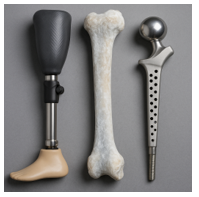Author: Cecilia Belzarena, MD, MPH, MBA
When a bone or soft tissue tumor requires surgery, one of the most important questions patients and families face is: How will the limb be reconstructed afterward? Advances in surgical techniques allow doctors to not only remove tumors safely but also restore function and quality of life. Below are the most common surgical options for reconstruction.
Limb-Salvage Surgery
In most cases, surgeons are able to remove the tumor while keeping the limb. This is called limb-sparing or limb-salvage surgery. The goal is to remove the tumor completely while preserving as much healthy bone, muscle, other soft tissues and joint function as possible. After the tumor is removed, reconstruction is usually needed to rebuild the limb and allow for movement and strength.
Amputation: When and Why
Although limb-salvage surgery is possible for the majority of patients, there are situations where amputation remains the safest option. This may be the case when:
- The tumor involves critical nerves or blood vessels that cannot be preserved,
- The tumor is very large, aggressive, has returned after a prior resection or
- There is an infection or other complications that make reconstruction unsafe.
Modern prosthetic limbs allow many patients to return to active and independent lives after amputation.

Amputation can be a good option in select cases, allowing patients to return to active, fulfilling lives with the help of modern prostheses and strong patient–surgeon support.
Reconstruction Options
After limb-salvage surgery, several reconstruction techniques may be used depending on the patient’s age, tumor location, and lifestyle goals:
- Endoprosthesis (Artificial Implants):
A metal and/or plastic prosthesis is used to replace the bone and sometimes the joint that has been removed. These implants can allow for immediate stability and early movement. In children, special “expandable” implants can even grow as the child grows, up to a certain extent. - Allograft (Donor Bone):
Bone from a donor (cadaver) can be used to replace the segment removed. Over time, the patient’s own bone may grow into the graft. While healing can take longer than with implants, this option may be especially useful in certain circumstances for example when a joint does not need to be replaced. - Allograft-Prosthetic Composite (APC):
This method combines a donor bone (allograft) with a prosthetic implant. The implant provides immediate strength and stability, while the donor bone can help restore muscle attachments and provide more natural or anatomic reconstruction in certain areas. - Bone Recycling (Autograft):
In select cases, the patient’s own tumor-bearing bone can be removed and then treated to kill tumor cells (with methods like freezing in liquid nitrogen or sterilization, among others) and then reimplanted. This allows patients to “recycle” their own bone as part of the reconstruction. - Rotationplasty:
This is a unique option, often used in children. After removing the part of the limb where the tumor is, the lower part of the leg is rotated and reattached at higher location, so that the ankle functions as a knee joint. A prosthesis is then fitted. Though it may look unusual or different, rotationplasty allows for excellent function and activity.

AI-generated illustration depicting (from left to right): a limb prosthesis, a cadaveric donor bone (allograft), and a metallic orthopedic prosthetic implant. These represent common reconstructive options in orthopedic oncology. For educational purposes only; not a clinical photograph.
Soft Tissue Reconstruction
Sometimes removing a tumor requires taking out not just bone, but also important muscles, skin, or tendons. In these cases, surgeons may use flap coverage (moving healthy tissue from another part of the body) to close the wound and protect implants or grafts. In addition, tendon transfers may be performed at the time of surgery—or later on—to help restore motion and strength. In more complex cases, reconstruction may also involve vascular bypass procedures to restore blood flow or nerve repair techniques to preserve or improve limb function. These procedures are an important part of ensuring both healing and long-term function.
Making the Best Choice
The choice of reconstruction is individualized. Surgeons consider many factors such as the type of tumor, the patient’s age, growth potential, activity level, and personal goals. Advances in surgical techniques and prosthetic design mean that most patients can expect to return to school, work, and activities they enjoy.
Your care team will discuss the best options with you, answer questions, and guide you in making a decision that balances tumor control with long-term function and quality of life.
Today, we have more options than ever before to help our patients after surgery for bone and soft tissue tumors. From advanced implants to unique reconstructive techniques, treatment can be tailored to each person’s needs and goals. It is important to have these conversations with your Orthopedic Oncologist—specialists who are trained to manage both tumor removal and reconstruction—so that patients and families feel confident they are making the best decision for their future.
This is not intended as a substitute for professional medical advice and does not provide advice on treatments or conditions for individual patients. All health and treatment decisions must be made in consultation with your physician(s), utilizing your specific medical information. Inclusion in this is not a recommendation of any product, treatment, physician or hospital.


